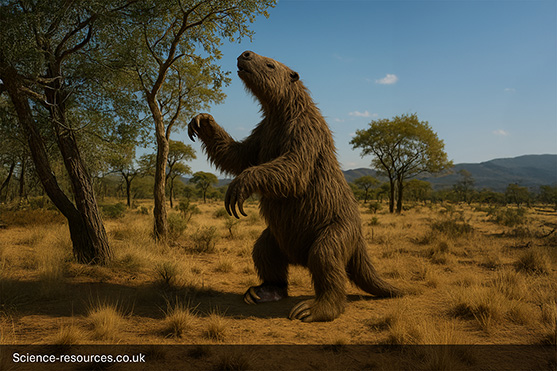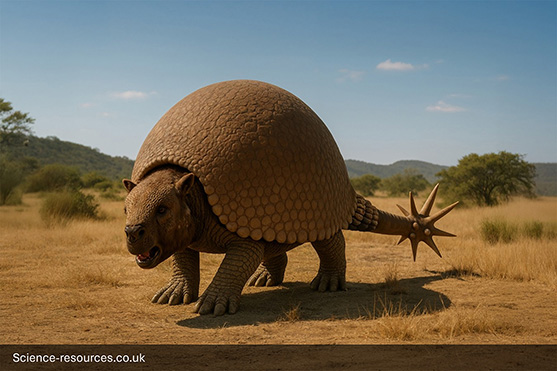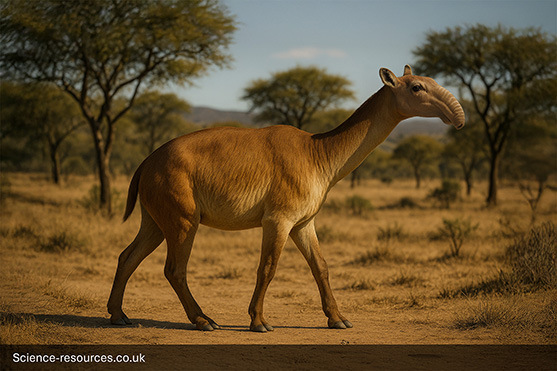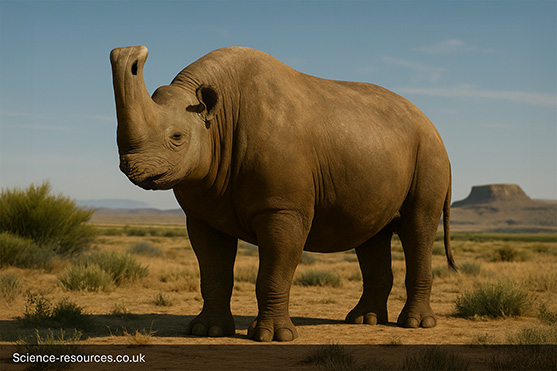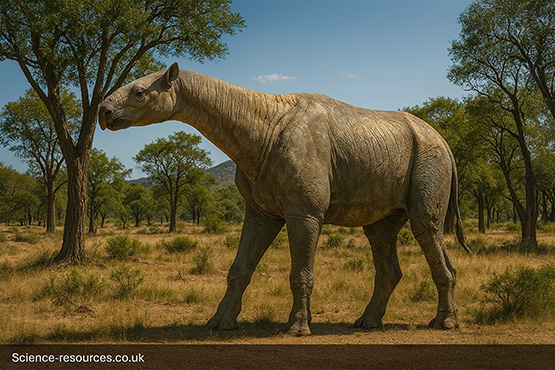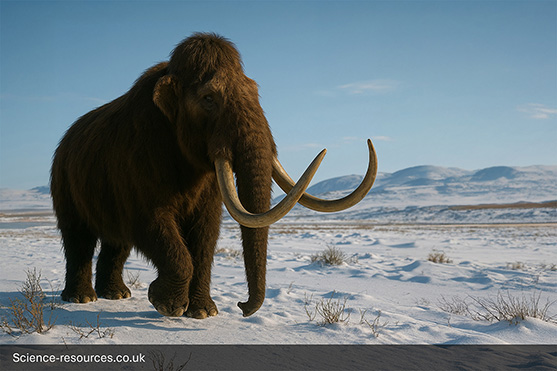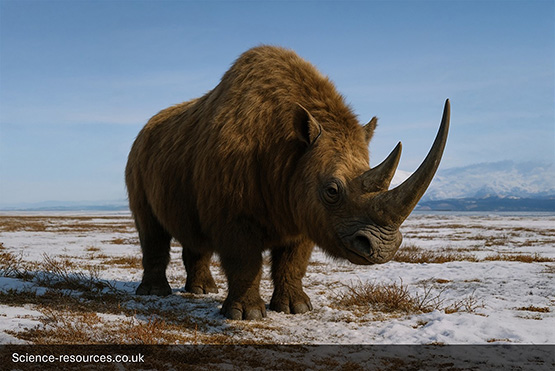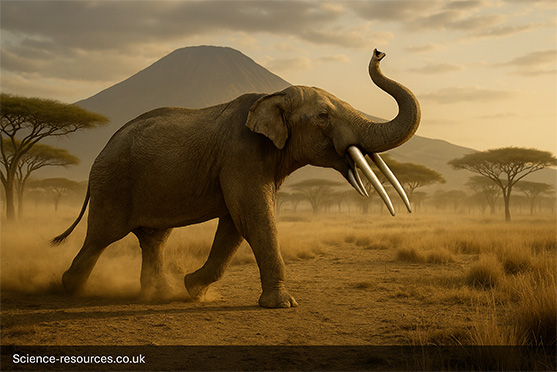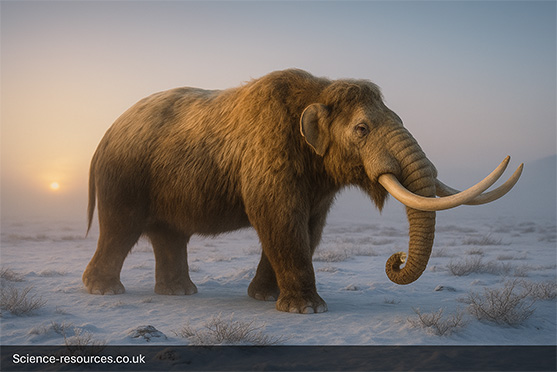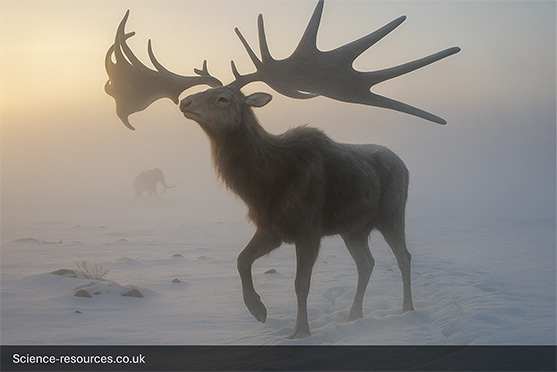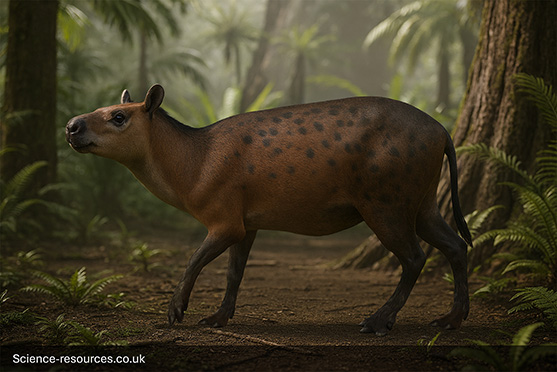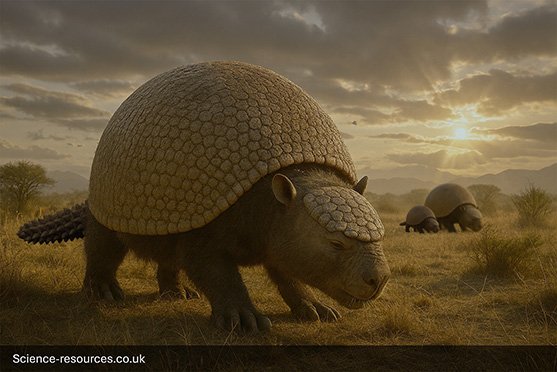Last updated: 4th August 2025
Type of Animal: Herbivores
Extinct Herbivorous Animals
This page focuses on the extinct animals that were herbivores. It highlights some of the most famous plant-eaters from different geological periods.
Megatherium
Megatherium was a giant ground sloth from South America that lived during the Pleistocene. It had massive claws and a bulky frame, feeding on leaves and possibly standing upright to reach higher branches.
Doedicurus
Doedicurus was a heavily armored mammal related to armadillos, living in South America during the Ice Age. It had a large, domed shell and a spiked tail used for defense against predators.
Macrauchenia
Macrauchenia was a long-necked, hoofed mammal from South America, resembling a camel with a short trunk. It lived from the Miocene to the Ice Age and grazed in open grasslands.
Embolotherium
Embolotherium was a rhino-like herbivore from the Eocene of Central Asia. It had a large, bony crest on its head, possibly used for display or sound resonance, and browsed on soft vegetation.
Indricothere
Indricothere was the largest land mammal ever to exist, living during the Oligocene. It was a hornless relative of the rhinoceros, with a long neck and massive body, feeding on treetop vegetation.
Mammoth
Woolly Mammoths were a giant, shaggy elephants that lived during the Pleistocene. they had long, curved tusks and a thick coat of fur, helping them survive in icy environments across Eurasia and North America.
Woolly Rhinoceros
Woolly Rhinoceros was a large Ice Age mammal adapted to cold climates. It had a thick coat of fur and a prominent curved horn, which it used to clear snow and graze on frozen grasslands.
Gomphothere
Gomphothere was a large, elephant-like mammal that roamed the Americas during the Ice Age. It had a long trunk and distinctive tusks, which it used to dig for roots and strip bark from trees. Unlike modern elephants, some species had four tusks and a flatter skull, helping them adapt to diverse environments.
Mastodon
Mastodon was a shaggy, elephant-like mammal that lived across North America during the Ice Age. It had straight tusks and a low, sloping skull, which helped it browse on shrubs and trees. Unlike mammoths, mastodons had cusped teeth suited for chewing tough vegetation in forested environments.
Megaloceros
Megaloceros was a giant deer that lived across Europe and Asia during the Ice Age. It had enormous, wide-spreading antlers and a strong, muscular build, which it used for display and defense. Often called the "Irish Elk," it grazed in open woodlands and meadows, feeding on grasses and shrubs.
Eohippus
Eohippus was one of the earliest known horse ancestors, living in North America during the early Eocene. The size of a small dog, Eohippus had multiple toes and a lightly built frame, adapted for forested environments. Its diet of soft vegetation and agility made it a successful browser in its ancient ecosystem.
Glyptodon
Glyptodon was a massive, armored mammal related to modern armadillos, living in South America during the Pleistocene. Protected by a domed shell and a spiked tail, it was a slow-moving herbivore that grazed on tough vegetation, using its size and defences to deter predators
You may also be intrested in:
- Extinct Animals: A-Z
- Dinosaurs: A-Z
Tags: Megatherium (Giant Ground Sloth), Doedicurus, Macrauchenia, Embolotherium, Indricothere, Woolly Mammoth, Woolly Rhino, Herbivores
© 2012 science-resources.co.uk. All rights reserved | Design by W3layouts
Type of Animal: Herbivores
Extinct Herbivorous Animals
This page focuses on the extinct animals that were herbivores. It highlights some of the most famous plant-eaters from different geological periods.
Megatherium
Megatherium was a giant ground sloth from South America that lived during the Pleistocene. It had massive claws and a bulky frame, feeding on leaves and possibly standing upright to reach higher branches.
Doedicurus
Doedicurus was a heavily armored mammal related to armadillos, living in South America during the Ice Age. It had a large, domed shell and a spiked tail used for defense against predators.
Macrauchenia
Macrauchenia was a long-necked, hoofed mammal from South America, resembling a camel with a short trunk. It lived from the Miocene to the Ice Age and grazed in open grasslands.
Embolotherium
Embolotherium was a rhino-like herbivore from the Eocene of Central Asia. It had a large, bony crest on its head, possibly used for display or sound resonance, and browsed on soft vegetation.
Indricothere
Indricothere was the largest land mammal ever to exist, living during the Oligocene. It was a hornless relative of the rhinoceros, with a long neck and massive body, feeding on treetop vegetation.
Mammoth
Woolly Mammoths were a giant, shaggy elephants that lived during the Pleistocene. they had long, curved tusks and a thick coat of fur, helping them survive in icy environments across Eurasia and North America.
Woolly Rhinoceros
Woolly Rhinoceros was a large Ice Age mammal adapted to cold climates. It had a thick coat of fur and a prominent curved horn, which it used to clear snow and graze on frozen grasslands.
Gomphothere
Gomphothere was a large, elephant-like mammal that roamed the Americas during the Ice Age. It had a long trunk and distinctive tusks, which it used to dig for roots and strip bark from trees. Unlike modern elephants, some species had four tusks and a flatter skull, helping them adapt to diverse environments.
Mastodon
Mastodon was a shaggy, elephant-like mammal that lived across North America during the Ice Age. It had straight tusks and a low, sloping skull, which helped it browse on shrubs and trees. Unlike mammoths, mastodons had cusped teeth suited for chewing tough vegetation in forested environments.
Megaloceros
Megaloceros was a giant deer that lived across Europe and Asia during the Ice Age. It had enormous, wide-spreading antlers and a strong, muscular build, which it used for display and defense. Often called the "Irish Elk," it grazed in open woodlands and meadows, feeding on grasses and shrubs.
Eohippus
Eohippus was one of the earliest known horse ancestors, living in North America during the early Eocene. The size of a small dog, Eohippus had multiple toes and a lightly built frame, adapted for forested environments. Its diet of soft vegetation and agility made it a successful browser in its ancient ecosystem.
Glyptodon
Glyptodon was a massive, armored mammal related to modern armadillos, living in South America during the Pleistocene. Protected by a domed shell and a spiked tail, it was a slow-moving herbivore that grazed on tough vegetation, using its size and defences to deter predators
Tags: Megatherium (Giant Ground Sloth), Doedicurus, Macrauchenia, Embolotherium, Indricothere, Woolly Mammoth, Woolly Rhino, Herbivores
© 2012 science-resources.co.uk. All rights reserved | Design by W3layouts
